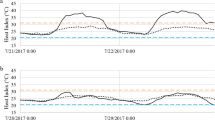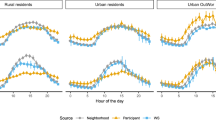Abstract
Wearable sensors have been used to collect information on individual exposure to excessive heat and humidity. To date, no consistent diurnal classification method has been established, potentially resulting in missed opportunities to understand personal diurnal patterns in heat exposure. Using individually experienced temperatures (IET) and heat indices (IEHI) collected in the southeastern United States, this work aims to determine whether current methods of classifying IETs and IEHIs accurately characterize “day,” which is typically the warmest conditions, and “night,” which is typically the coolest conditions. IET and IEHI data from four locations were compared with the closest hourly weather station. Different day/night classifications were compared to determine efficacy. Results indicate that diurnal IET and IEHI ranges are higher than fixed-site ranges. Maximum IETs and IEHIs are warmer and occur later in the day than ambient conditions. Minimum IETs are lower and occur earlier in the day than at weather stations, which conflicts with previous assumptions that minimum temperatures occur at night. When compared to commonly used classification methods, a method of classifying day and night based on sunrise and sunset times best captured the occurrence of maximum IETs and IEHIs. Maximum IETs and IEHIs are often identified later in the evening, while minimum IETs and IEHIs occur throughout the day. These findings support future research focusing on nighttime heat exposure, which can exacerbate heat-related health issues, and diurnal patterns of personal exposure throughout the entire day as individual patterns do not necessarily follow the diurnal pattern seen in ambient conditions.

Similar content being viewed by others
Data availability
The datasets generated and analyzed during the current study are available from the corresponding author on reasonable request.
References
Anderson BG, Bell ML (2012) Weather-related mortality: how heat, cold, and heat waves affect mortality in the United States. Epidemiology 20:205–213. https://doi.org/10.1097/EDE.0b013e318190ee08.Weather-Related
Anderson GB, Peng RD, Ferreri JM (2016) Weathermetrics: functions to convert between weather metrics. R package version 1.2.2. https://cran.r-project.org/web/packages/weathermetrics/index.html. Accessed 1 Feb 2018
Bailey E, Fuhrmann C, Runkle J et al (2020) Wearable sensors for personal temperature exposure assessments: a comparative study. Environ Res 180:108858. https://doi.org/10.1016/J.ENVRES.2019.108858
Basu R (2009) High ambient temperature and mortality: a review of epidemiologic studies from 2001 to 2008. Environ Health 8:40. https://doi.org/10.1186/1476-069X-8-40
Bernhard MC, Kent ST, Sloan ME et al (2015) Measuring personal heat exposure in an urban and rural environment. Environ Res 137:410–418. https://doi.org/10.1016/J.ENVRES.2014.11.002
ClimateData.org Climate data for cities worldwide - Climate-Data.org. In: 2021. https://en.climate-data.org/. Accessed 7 Dec 2021
Earl N, Simmonds I, Tapper N (2016) Weekly cycles in peak time temperatures and urban heat island intensity. Environ Res Lett 11:074003. https://doi.org/10.1088/1748-9326/11/7/074003
Ellis KN, Hathaway JM, Mason LR et al (2017) Summer temperature variability across four urban neighborhoods in Knoxville, Tennessee, USA. Theor Appl Climatol 127:701–710. https://doi.org/10.1007/s00704-015-1659-8
Estoque RC, Murayama Y, Myint SW (2017) Effects of landscape composition and pattern on land surface temperature: an urban heat island study in the megacities of Southeast Asia. Sci Total Environ 577:349–359. https://doi.org/10.1016/J.SCITOTENV.2016.10.195
Fischer EM, Schär C (2010) Consistent geographical patterns of changes in high-impact European heatwaves. Nat Geosci 3:398–403. https://doi.org/10.1038/ngeo866
Gasparrini A, Guo Y, Hashizume M (2015) Mortalité attribuable au froid et à la chaleur : analyse multi-pays. Environ Risques Sante 14:464–465. https://doi.org/10.1016/S0140-6736(14)62114-0/ATTACHMENT/3DAAC933-D843-4742-95CD-07CAE706F14F/MMC1.PDF
Harlan SL, Brazel AJ, Prashad L et al (2006) Neighborhood microclimates and vulnerability to heat stress. Soc Sci Med 63:2847–2863. https://doi.org/10.1016/j.socscimed.2006.07.030
Hass AL, Ellis KN (2019a) Using wearable sensors to assess how a heatwave affects individual heat exposure, perceptions, and adaption methods. Int J Biometeorol 63. https://doi.org/10.1007/s00484-019-01770-6
Hass AL, Ellis KN (2019b) Motivation for heat adaption: how perception and exposure affect individual behaviors during hot weather in Knoxville, Tennessee. Atmosphere (Basel) 10. https://doi.org/10.3390/atmos10100591
Hass AL, Ellis KN, Mason LR et al (2016) Heat and humidity in the city: neighborhood heat index variability in a mid-sized city in the southeastern United States. Int J Environ Res Public Health 13. https://doi.org/10.3390/ijerph13010117
Hass AL, Runkle JD, Sugg MM (2021) The driving influences of human perception to extreme heat: a scoping review. Environ Res 197:111173. https://doi.org/10.1016/j.envres.2021.111173
Henry R (2015) Etymologia: bonferroni correction - Volume 21, Number 2—February 2015 - Emerging Infectious Diseases journal - CDC. Emerg Infect Dis 21:289. https://doi.org/10.3201/EID2102.ET2102
Hoffman JS, Shandas V, Pendleton N (2020) The effects of historical housing policies on resident exposure to intra-urban heat: a study of 108 US urban areas. Climate 8:12. https://doi.org/10.3390/cli8010012
Hondula DM, Kuras ER, Betzel S et al (2021) Novel metrics for relating personal heat exposure to social risk factors and outdoor ambient temperature. Environ Int 146:106271. https://doi.org/10.1016/j.envint.2020.106271
Hsu A, Sheriff G, Chakraborty T (2021) Manya D (2021) Disproportionate exposure to urban heat island intensity across major US cities. Nat Commun 121(12):1–11. https://doi.org/10.1038/s41467-021-22799-5
Kalkstein AJ, Sheridan SC (2007) The social impacts of the heat-health watch/warning system in Phoenix, Arizona: assessing the perceived risk and response of the public. Int J Biometeorol 52:43–55. https://doi.org/10.1007/s00484-006-0073-4
Kidder SQ, Essenwanger OM (1995) The effect of clouds and wind on the difference in nocturnal cooling rates between urban and rural areas. J Appl Meteorol 34:2440–2448. https://doi.org/10.1175/1520-0450(1995)034%3c2440:teocaw%3e2.0.co;2
Kuras ER, Hondula DM, Brown-Saracino J (2015) Heterogeneity in individually experienced temperatures (IETs) within an urban neighborhood: insights from a new approach to measuring heat exposure. Int J Biometeorol 59:1363–1372. https://doi.org/10.1007/s00484-014-0946-x
Kuras ER, Richardson MB, Calkins MM et al (2017) Opportunities and challenges for personal heat exposure research. Environ Health Perspect 125:1–9. https://doi.org/10.1289/EHP556
Manoli G, Fatichi S, Bou-Zeid E, Katul GG (2020) Seasonal hysteresis of surface urban heat islands. Proc Natl Acad Sci U S A 117:7082–7089. https://doi.org/10.1073/PNAS.1917554117/-/DCSUPPLEMENTAL
Mehdipoor H, Vanos JK, Zurita-Milla R (2017) Cao G (2017) Short communication: emerging technologies for biometeorology. Int J Biometeorol 611(61):81–88. https://doi.org/10.1007/S00484-017-1399-9
Murage P, Hajat S, Kovats RS (2017) Effect of night-time temperatures on cause and age-specific mortality in London. Environ Epidemiol 1:e005. https://doi.org/10.1097/EE9.0000000000000005
National Weather Service (2021a) Heat watch vs. warning. https://www.weather.gov/safety/heat-ww. Accessed 8 Dec 2021
National Weather Service (2021b) NWS blacksburg watch, warning, & advisory definitions and criteria. https://www.weather.gov/rnk/criteria#heat. Accessed 8 Dec 2021
Oke TR (1973) City size and the urban heat island. Atmos Environ 7:769–779. https://doi.org/10.1016/0004-6981(73)90140-6
Powell EJ, Keim BD (2015) Trends in daily temperature and precipitation extremes for the southeastern United States: 1948–2012. J Clim 28:1592–1612. https://doi.org/10.1175/JCLI-D-14-00410.1
Rennie J, Bell JE, Kunkel KE et al (2019) Development of a submonthly temperature product to monitor near-real-time climate conditions and assess long-term heat events in the United States. J Appl Meteorol Climatol 58:2653–2674. https://doi.org/10.1175/JAMC-D-19-0076.1
Royé D, Sera F, Tobías A et al (2021) Effects of hot nights on mortality in Southern Europe. Epidemiology 487–498.https://doi.org/10.1097/EDE.0000000000001359
Runkle JD, Cui C, Fuhrmann C et al (2019) Evaluation of wearable sensors for physiologic monitoring of individually experienced temperatures in outdoor workers in southeastern U.S. Environ Int 129:229–238. https://doi.org/10.1016/j.envint.2019.05.026
Sheridan SC (2007) A survey of public perception and response to heat warnings across four North American cities: an evaluation of municipal effectiveness. Int J Biometeorol 52:3–15. https://doi.org/10.1007/s00484-006-0052-9
Shi Z, Xu X, Jia G (2021) Urbanization magnified nighttime heat waves in China. Geophys Res Lett 48:e2021GL093603. https://doi.org/10.1029/2021GL093603
Soltani A, Sharifi E (2017) Daily variation of urban heat island effect and its correlations to urban greenery: a case study of adelaide. Front Archit Res 6:529–538. https://doi.org/10.1016/J.FOAR.2017.08.001
Sugg MM, Fuhrmann CM, Runkle JD (2018) Temporal and spatial variation in personal ambient temperatures for outdoor working populations in the southeastern USA. Int J Biometeorol 62:1521–1534. https://doi.org/10.1007/s00484-018-1553-z
Sugg MM, Stevens S, Runkle JD (2019) Estimating personal ambient temperature in moderately cold environments for occupationally exposed populations. Environ Res 173:497–507. https://doi.org/10.1016/j.envres.2019.03.066
U.S. Global Change Research Program (2018) Fourth national climate assessment, pp 1–470. https://nca2018.globalchange.gov/. Accessed 19 Nov 2021
Uejio CK, Morano LH, Jung J et al (2018) Occupational heat exposure among municipal workers. Int Arch Occup Environ Health 91:705–715. https://doi.org/10.1007/s00420-018-1318-3
Uejio CK, Wilhelmi OV, Golden JS et al (2011) Intra-urban societal vulnerability to extreme heat: the role of heat exposure and the built environment, socioeconomics, and neighborhood stability. Health Place 17:498–507. https://doi.org/10.1016/j.healthplace.2010.12.005
United States Census Bureau (2021) U.S. census bureau quickfacts: United States. https://www.census.gov/quickfacts/fact/table/US/PST045219. Accessed 7 Dec 2021
Wang J, Chen Y, Tett SFB et al (2020) (2020) Anthropogenically-driven increases in the risks of summertime compound hot extremes. Nat Commun 111(11):1–11. https://doi.org/10.1038/s41467-019-14233-8
Wang S, Wu CYH, Richardson MB et al (2021) Characterization of heat index experienced by individuals residing in urban and rural settings. J Expo Sci Environ Epidemiol 31:641–653. https://doi.org/10.1038/s41370-021-00303-x
Ye X, Wolff R, Yu W et al (2012) Ambient temperature and morbidity: a review of epidemiological evidence. Environ Health Perspect 120:19–28. https://doi.org/10.1289/EHP.1003198
Author information
Authors and Affiliations
Corresponding author
Ethics declarations
Conflict of interest
The authors declare no competing interests.
Additional information
Publisher’s note
Springer Nature remains neutral with regard to jurisdictional claims in published maps and institutional affiliations.
Rights and permissions
About this article
Cite this article
Hass, A.L., McCanless, K., Cooper, W. et al. Heat exposure misclassification: Do current methods of classifying diurnal range in individually experienced temperatures and heat indices accurately reflect personal exposure?. Int J Biometeorol 66, 1339–1348 (2022). https://doi.org/10.1007/s00484-022-02280-8
Received:
Revised:
Accepted:
Published:
Issue Date:
DOI: https://doi.org/10.1007/s00484-022-02280-8




